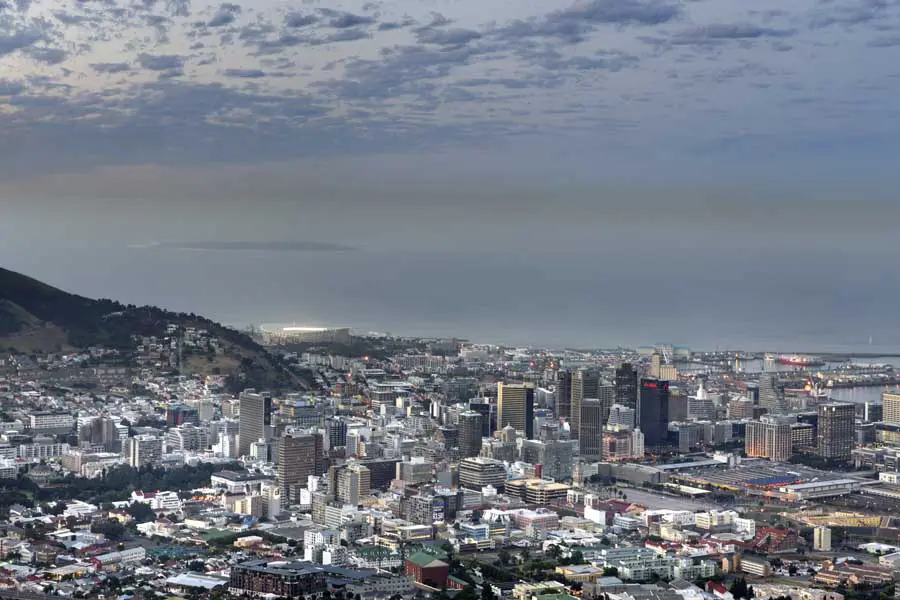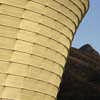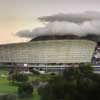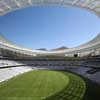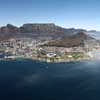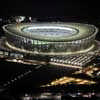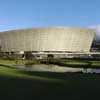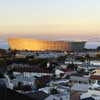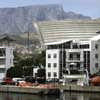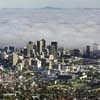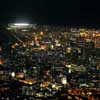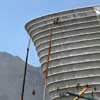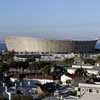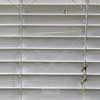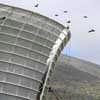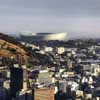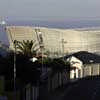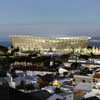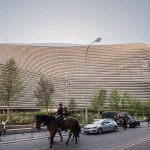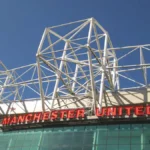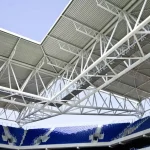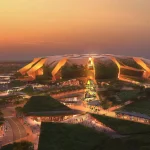Cape Town Stadium, Green Point Arena Building, FIFA World Cup 2010 South Africa
Green Point Stadium, Cape Town
South Africa Arena Building, Location, Capacity: Football World Cup Sports Venue
8 Jun 2010
World Cup Stadiums South Africa
There are ten stadiums in the 2010 Soccer World Cup in South Africa
Five of them are new, including this one, the third largest after Soccer City Stadium.
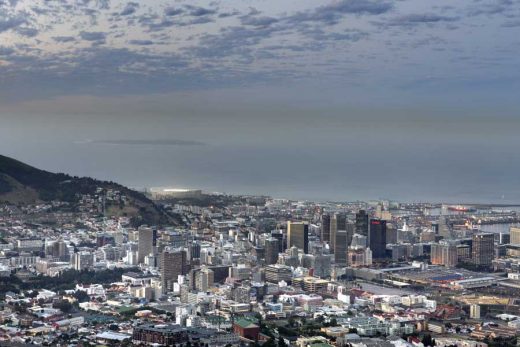
photograph © Marcus Bredt, Berlin
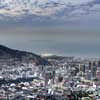

pictures © Marcus Bredt, Berlin
Cape Town Stadium, Cape Town, South Africa
Design: gmp Architekten von Gerkan, Marg und Partner
The skyline of Cape Town is dominated by Table Mountain, Signal Hill and the Atlantic Ocean. Cape Town Stadium forms a landmark at the foot of Signal Hill, and fits respectfully into its environment.
The challenge was to create a standalone building in this unique location that enriches rather than mars the world-famous picture-postcard setting.
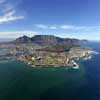
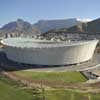
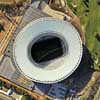
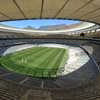
photos © Bruce Sutherland, Cape Town
Specifically, the job was to design a stadium on part of Green Point Common, an 80ha public park in the city center that would become iconic of Cape Town. The Common also contains South Africa’s oldest golf course and oldest rugby club.
It is surrounded by residential areas, and is close to Cape Town’s central business district on the old Victoria & Alfred Waterfront, which is now the city’s main tourist attraction.
Green Point Common has history in Cape Town. It was a rocky wasteland until, in 1923, the government of the Union of South Africa made it over to the city as common land on which recreational areas and sports facilities would be set up.
Over the past decades, the area of common land has been whittled away, most of it no longer being accessible to the public, having been leased to private sports clubs and other organizations.
After careful political consideration, it was decided to locate the stadium so as to forge a link between the commercial center and Green Point Common, and reorganize the existing sports facilities. Fort Wynyard artillery fort, Green Point cricket ground and the golf club were integrated into the public park.
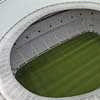
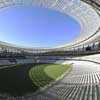
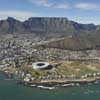
photos © Bruce Sutherland, Cape Town
Together with the horizontal line of Table Mountain and the rounded top of Signal Hill, the curving contours of the stadium act as a kind of bottom note in a harmonious triad. Lightweight in concept, the circular stadium comes across as unobtrusive and respectful of its surroundings.
Its appearance varies greatly with the typical lighting conditions of the area. With its translucent external skin, it reacts to different weather and daylight conditions at different times of the day or seasons, and diverse lighting effects give it a sculptural look.
This design concept was combined with the purely functional requirements. For spectators, it provides a logical but sensory structure, and inside the stadium engenders a terrific atmosphere during soccer and rugby matches and concerts alike. The stadium provides seats for 68,000 spectators, arranged on three tiers, 2,400 of them for business and a further 2,500 in boxes.
Broad access promenades on Levels 2 and 6 form “lobbies” round the stadium arena, allowing visitors freedom of movement, a pleasant environment to linger in and ease of orientation round the stadium. The pitch is visible from the “lobby”. The upper “lobby” at a height of 25m offers a panoramic view over Green Point Common, the city and the ocean.
The parabolic profile of the stands gives all spectators an optimal view of the pitch. The strongly curving outline of the top tier contrasting with the more muted curves of the roof edge is a result of their functional geometry.
During the 2010 soccer World Cup, temporary rows of seating will be installed on either side on the top tier, but these are due to be replaced later by events suites and clubrooms. That will reduce seating capacity from 68,000 to 55,000 but increase the number of rentable areas, so as contribute to the commercial viability of the stadium post-World Cup.
One critical objection to the politically motivated location in a small-scale setting was the height of the stadium. Due to the rocky subsoil, the pitch and bottom tier could not be sunk into the ground. To reduce the apparent height of the stadium, therefore, the architects provided an elevated plateau as an artificial landscape feature that mediates between the surroundings and the stadium and lessens the perceived height of the stadium.
Broad ramps and steps on three sides lead up to this plateau, under which is parking space for over 1,200 cars, a goods delivery area and access for fire engines and emergency services.
The need to weigh down the flat suspended roof against aerodynamic uplift and achieve rainwater runoff without pumps prompted us to come up with an innovative structural solution: a synthesis of a saddle-shaped, curved suspension roof and a truss-girder system, with heavy glass roofing to prevent wind suction upwards.
These steel truss girders on load-bearing cables form the core of a roof structure clad on both sides. The 36,000m² roof is made of laminated glass. The inner, 16m-wide ring consists of clear glass so that the pitch gets a lot of natural light, while the external glass areas are enameled, to reduce heat dissipation and cut the light intensity by about 80%.
The underside of the roof structure is, like the façades, clad with a translucent membrane, which not only covers the technical installations but also provides sound insulation. The loudspeaker system, floodlighting and stand lighting systems were integrated into the roof. Despite the total glass weight of 4,500 tons, the roof is still a lightweight structure compared with roofs of similar size.
The façade was designed as a horizontally profiled membrane. Its undulating silhouette transforms the stadium into a large-scale, translucent sculpture. The membrane is a semi-transparent glass fabric with a silver coating, enveloping the load-bearing structure like a veil while allowing glimpses of the interior.
In the highly changeable weather conditions in Cape Town, it offers frequently changing reflections—like the changing light conditions and moods of the day: white and light on bright summer days and shrouded in grey on stormy winter days. At sunset, the stadium is bathed in a reddish glow. At night, it gleams like a Chinese lantern, revealing its interior.
Cape Town’s world-famous skyline has acquired a new architectural feature. The new stadium has unobtrusively taken its place in the impressive urban landscape of the Cape of Good Hope and in the hearts of South African citizens whatever their ethnic origin.
Cape Town Stadium : Building Information
Consultancy: 2006 – 1. Preis/1st prize
Design: Volkwin Marg and Hubert Nienhoff with Robert Hormes
Project leader: Robert Hormes
Project leader roof: Martin Glass
Project management: Michèle Rüegg
Staff in alphabetical order: Sophie Altrock, Holger Betz, Christian Blank, Margret Böthig, Lena Brögger, Maike Carlsen, Chris Hättasch, Patrick Hoffmann, Andrea Jobski, Martin Krebes, Helge Lezius
Cooperation with: Louis Karol architects, Point architects, Cape Town
Structural concept and design roof: Schlaich Bergermann und Partner – Knut Göppert with Thomas Moschner
Structural engineering: BKS (Pty) Ltd, Iliso Consulting, Henry Fagan & Partners, KFD Wilkinson, Arcus Gibb, Cape Town
Technical equipment: BKS (Pty) Ltd, WSP (Pty) Ltd, Ilsio Consulting, Goba Consulting, Cape Town
Urban design: Comrie Wilkinson architects & urban designers, Jakupa Architects and urban designers, OvP Associates Landscape Architects, Cape Town
Landscape design: OvP Associates Landscape Architects, Cape Town
Architects on site: BKS (Pty) Ltd, Cape Town
General project management: MDA Mitchell du Plessis Associates, BKS (Pty) Ltd, Ariya project managers, Cape Town
General contractor: JV Murray & Roberts, WBHO (Dach Roof), JV Pfeifer Seil- und Hebetechnik & Birdair
Client: City of Cape Town, spv 2010
Construction period: 2007-10
Gross floor area: 110.000 m²
Tiers: 3
Seats: 68.000
VIP boxes: 134
Business seats: 2.800
Places for wheelchair users: 120
Places for press: 290
Underground parking places for cars: 1.200
Length of the stadium: 290 m
Width of the stadium: 270 m
Height of the stadium: 48 m
Roof surface area: 36.000 m²
Roof: Laminated glass and diaphanous PVC membrane
Green Point Stadium, Cape Town, FIFA World Cup 2010, South Africa images / information from gmp Architekten von Gerkan, Marg und Partner
Boogertman Urban Edge and Partners in partnership with Populous
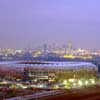
image : Boogertman Urban Edge and Partners / Populous
Soccer City Stadium
South Africa World Cup Stadiums – New
Five new football stadiums will be built for the World Cup
Green Point stadium, Cape Town (rebuilt)
Mbombela, Mpumalanga
Moses Mobhida (former King Senzangakhona Stadium), Durban (rebuilt)
Nelson Mandela Metro, Port Elizabeth, Eastern Cape
Peter Mokaba stadium, Polokwane, Limpopo (rebuilt)
South African World Cup Stadium Capacities
South Africa football stadium capacities
95,000 : Soccer City, Johannesburg
70,000 : Moses Mobhida King Senzangakhona Stadium, Durban
68,000 : Green Point stadium, Cape Town
60,000 : Ellis Park, Johannesburg
50,000 : Nelson Mandela Metro, Port Elizabeth, Eastern Cape
45,000 : Loftus Versfeld, Pretoria
40,000 : Mbombela, Mpumalanga
40,000 : Peter Mokaba stadium, Polokwane, Limpopo
40,000 : Royal Bafokeng stadium, Rustenburg
40,000 : Vodacom Park, Bloemfontein
South African World Cup Stadiums
Cape Town Stadium architects (consultant) : von Gerkan, Marg and Partners (gmp)
More information online re South African World Cup Stadiums soon
Location: Cape Town, South Africa
Architecture in South Africa
South Africa Architecture Designs – chronological list
Football Stadium Buildings – Selection
, Barcelona, Spain
Foster + Partners
Nou Camp Stadium
Emirates Stadium building : Arsenal FC, London, UK
HOK Sport Architecture
Emirates Football Stadium Building
Real Madrid Football Stadium Building
Circa on Jellicoe Building, Johannesburg
studioMAS architects + urban designers
Circa on Jellicoe Building
Mapungubwe Interpretation Centre Building
Peter Rich Architects
South African Interpretation Centre : WAF World Building of the Year
African Buildings : major developments + building projects in Africa
Comments / photos for the Green Point Stadium South African World Cup Architecture page welcome

